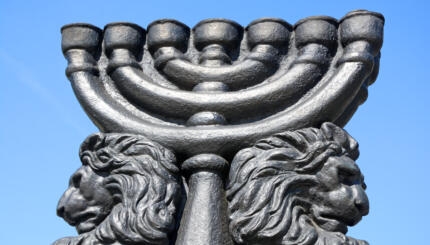Commentary on Parashat Re'eh, Deuteronomy 11:26-16:17
In Parashat Re’eh, the Israelites are given intimation of the shape of their future society across the Jordan River. The portrait of the Israelites’ world-to-come generally radiates an exuberant sense of well-being — reflecting a society contentedly organized and functioning smoothly.
The desert nomads are regaled with how they will yearly process to a central site for the dedication of their agricultural bounty. Here, they will “rejoice before the Lord your God with your sons and daughters and with your male and female slaves…” And if the way is too long to travel with such plenty, the pilgrim will exchange his bounty for money to spend at God’s designated site on “anything you may desire” (Deuteronomy 12:12, 14:23, and 14:25-26).
In this halcyon world, the bounty of the land will be mirrored in a generous social order: Debts will be remitted and slaves freed each seventh year — sent off with gifts from their masters “out of the flock, threshing floor, and vat.” The “stranger, the fatherless, and the widow” will celebrate the festivals with each household. And, if God’s commands are hearkened: “There shall be no needy among you…” (Deuteronomy 15:1, 15:12-13, 16:14, and 15:4). With these tantalizing promises of communal celebration and a caring civil society, Parashat Re’eh holds out the promise of idyll, plenty, and joy.
There are, however, fissures veining the serene portrait. Until the people have “come to the resting place, to the allotted haven,” this bountiful existence will not be fully realized. The world of festive in-gatherings and pilgrimages will not be established until God “grants you safety from all your enemies around you and you live in security” (Deuteronomy 12: 9-10). Realizing the promise of the well-ordered, abundant society that our parashah describes depends thus not only on arrival in the land, but also on reaching a state of peace therein.
With your help, My Jewish Learning can provide endless opportunities for learning, connection and discovery.
Ushering in Peace
The Israelites accordingly are commanded to eliminate sources of conflict–both external and internal–in settling their new world. They are to destroy all vestiges of Canaanite idol worship. Israelite cities that have strayed into idolatrous practice must be razed, and false prophets are to be cut down (Deuteronomy 12:2-3; 13:2-18). Until they have emerged from this period of destruction, the parashah seems to imply, the Israelites will not realize the golden promise of their thriving society.
This approach to achieving peace and stability–the total eradication of conflict through violence–is of course understood today to be facile, cruel, and ultimately unwise. Conflict cannot simply be excised tumor-like from society, and such blunt efforts to do so will likely only bring on its metastasization. Indeed, we have come to understand that conflict’s debilitating effects linger long after formal hostilities have ended.
How Internal Conflict Affects Stability and Growth
In his lucid book, The Bottom Billion, economist Paul Collier identifies violent conflict among the several “development traps” that keep those in the world’s poorest countries–“the bottom billion”–from thriving. Specifically focusing on internal conflicts — civil wars and coups — Collier details how such instability stalks and then dismantles progress in the world’s poorest regions, effecting “development in reverse.” Collier reports that 73% of people in the world’s poorest countries are currently in, or have recently been through, a civil war, and that the experience of these persistent conflicts plays a significant role in “trapping” countries in poverty.
Civil wars, in Collier’s estimation, reduce growth by 2.3 percent per year. And critically, economic decline persists well after fighting has ceased. Lasting about seven years, a typical civil war thus leaves a country about 15% poorer than it would have been at peace. The war-torn Democratic Republic of Congo, for example, will require about 50 years of continuous peace at its current growth rate to simply return to its income levels of 1960.
Avoiding Conflict
With such debilitating consequences, violent conflicts are thus a formidable barrier to poor countries’ development–much less to achieving the sort of serene society depicted in our Torah portion. But here Collier’s analysis provides some hope and circles back to the symbiosis between peace and societal flourishing articulated in Parashat Re’eh.
The strongest predictors for conflict, Collier argues, are not a country’s political, historical, or ethnic configurations, but their economies. More than any other factors, low income and slow growth make it likely that a country will become mired in war. That is, while conflict impedes growth and reduces income, the relationship simultaneously holds the other way too: Poverty breeds conflict.
To build societies in our Torah portion’s image, it may thus be wisest to heed its own admonishment: “Do not harden your heart and shut your hand against your needy brother. Rather, you must open your hand and lend him sufficient for whatever he needs” (Deuteronomy 15: 7-8). When we do so, we invite the possibility that from our open hands will not only fall seeds of prosperity — but also of peace.
For further discussion of The Bottom Billion, part of AJWS’s Global Justice Book and Film Forum, please click here.
Provided by American Jewish World Service, pursuing global justice through grassroots change.
Torah
Pronunced: TORE-uh, Origin: Hebrew, the Five Books of Moses.


